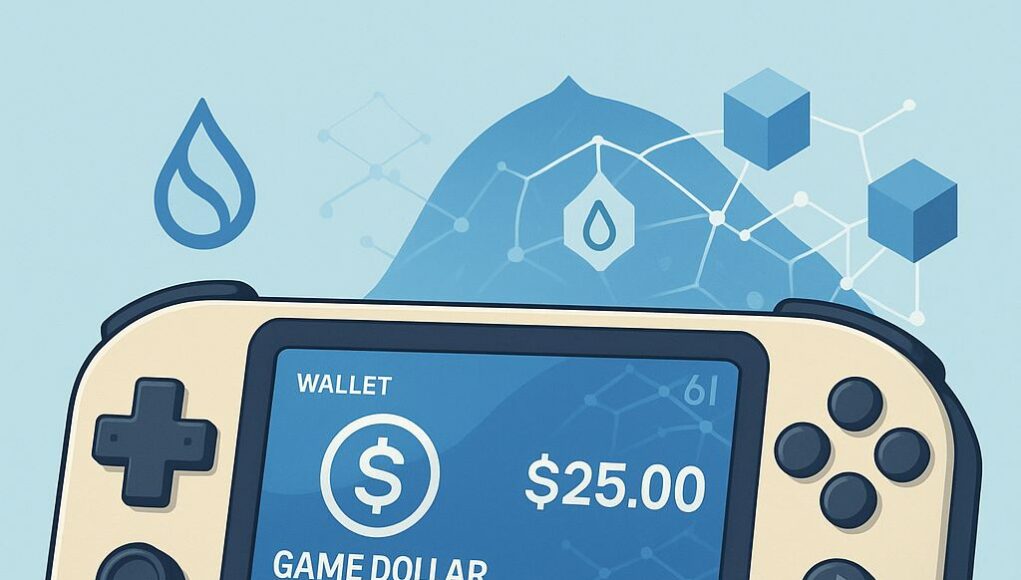With its upcoming Linux-based GameOS console and the launch of Game Dollar on the Sui blockchain, Playtron is crafting a vertically integrated Web3 gaming ecosystem. Unlike most blockchain gaming efforts, Playtron controls both the hardware and the in-game economy. It created a unique opportunity to reshape the user experience from the ground up. It’s not just about better payments, it’s about owning the rails.
A Stablecoin Built for Gaming
At the heart of this strategy is Game Dollar, a dollar-pegged stablecoin designed specifically for gaming transactions. Powered by M0, a decentralized stablecoin protocol, and supported by payment infrastructure provider Bridge, Game Dollar aims to be the primary currency for in-game purchases, rewards, and subscriptions across Playtron’s ecosystem. The stablecoin is set to go live in Q4 2025, aligned with the release of Playtron’s new handheld console, SuiPlay0X1.
Vertical Integration from Hardware to Marketplace
What sets Playtron apart is its end-to-end approach. Unlike traditional gaming companies that rely on third-party platforms or existing blockchain layers, Playtron is building its entire stack in-house. GameOS, its custom Linux-based operating system, will come pre-installed on the SuiPlay0X1. It will allow seamless integration with Game Dollar and the Sui blockchain from day one. The company designed the console for both Web2 and Web3 games, potentially widening its user base beyond the crypto-native crowd.
Infrastructure and Payment Rails
Game Dollar will be issued and maintained using M0’s smart contracts and infrastructure, aiming to keep the coin pegged to the U.S. dollar while remaining composable with other decentralized finance (DeFi) tools. Bridge will facilitate fiat on-ramps and off-ramps, ensuring that users can easily convert between traditional currencies and Game Dollar within the Playtron interface.
Owning the Ecosystem with Playtron Select
The company is also integrating its own curated storefront, Playtron Select. In the store, users can buy games and in-game items directly using Game Dollar. This creates a closed-loop payment system that gives Playtron both revenue capture and data control. By unifying hardware, operating system, payment layer, and marketplace, Playtron is effectively positioning itself as a Web3-native version of platforms like Steam or the Epic Games Store. But decentralized payments and ownership are baked in.
Strategic Positioning in a Fragmented Industry
Analysts note that this level of vertical integration is rare in the blockchain gaming space, often marked by fragmentation and a reliance on speculative tokens. By contrast, Playtron’s use of a stablecoin is a deliberate attempt to offer a predictable and user-friendly alternative to volatile crypto assets. The partnership with Sui is strategic as well. The Sui blockchain’s low fees and high throughput capabilities are crucial for gaming use cases.
>>> Read more: Play-to-Earn Crypto Games
Whether Playtron’s model will scale remains to be seen. Adoption will depend on the appeal of the hardware, but also on whether developers choose to build for the ecosystem. Not least important, will gamers embrace a stablecoin-based economy? Nevertheless, controlling its infrastructure end-to-end uniquely positions Playtron to experiment, iterate, and potentially define what a truly tokenized gaming experience can look like.
Readers’ frequently asked questions
How will I actually get and use Game Dollar if I’m not already using crypto?
You won’t need to be an experienced crypto user to start using Game Dollar. Playtron is integrating fiat on-ramps into its ecosystem via a provider called Bridge. You’ll be able to buy Game Dollars directly with your credit card or bank account through the console or Playtron’s interface, just like topping up a digital wallet in an app. Similarly, if you want to cash out, Bridge supports off-ramps to convert Game Dollars back into traditional currency. The game developers want to make the experience feel familiar, even if you’ve never used crypto before.
Is Game Dollar just another crypto token that might lose value?
No, it is not. Unlike typical gaming or Web3 tokens that fluctuate in price, Game Dollar is a stablecoin. It’s pegged to the U.S. dollar and built using infrastructure from M0, which is designed to keep it stable and predictable. One Game Dollar will always equal one U.S. dollar. It’s not an investment token; it’s a payment tool meant to remove volatility and simplify in-game transactions.
Will I be able to use Game Dollar in other games or stores outside of Playtron?
At launch, Game Dollar will primarily be in use within Playtron’s own ecosystem, including its handheld console, storefront (Playtron Select), and supported games. However, because it’s built on the Sui blockchain and uses decentralized infrastructure, it’s technically possible that other game developers or platforms could adopt it in the future. But for now, Playtron plans to use it within its own vertically integrated system only. The company will maintain full control over the gaming and payment experience.
What Is In It For You? Action Items You Might Want to Consider
Monitor the rollout of Game Dollar and the SuiPlay0X1 console in Q4 2025
New stablecoins usually fly under the radar, but Game Dollar could quietly carve out a strong utility niche in Web3 gaming. If adoption gains momentum via Playtron’s curated storefront and hardware, early ecosystem alignment could present unique DeFi or liquidity opportunities on Sui.
Keep an eye on M0 and Bridge as infrastructure plays
Behind every new stablecoin is a protocol story worth watching. M0’s involvement in issuing Game Dollar could put it in the spotlight, especially if Game Dollar gains transactional volume. Likewise, Bridge’s fiat gateway services could become essential infrastructure if the user experience proves frictionless.
Explore early builder activity in the Playtron-Sui ecosystem
Whether you’re a gamer, investor, or dev, ecosystems with unified hardware, payment rails, and marketplaces tend to create sticky user bases. Consider scouting early GameOS or SuiPlay0X1 titles and communities. They could offer edge cases or early signals on broader Sui-based gaming traction.










